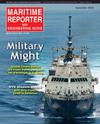
Page 17: of Maritime Reporter Magazine (September 2016)
Maritime & Ship Security
Read this page in Pdf, Flash or Html5 edition of September 2016 Maritime Reporter Magazine
is becoming increasingly important as exist, but to a less extent, such as poly- cat ? nes to the engine, thereby increas- your investment. You will be surprised more ‘problematic’ fuels enter the sup- mer contamination and poor ignition ing the potential for engine wear. how much you can save, and protect the ply chain. This is not the result of de- fuel. More than 60% of the high sulfur Polymer contamination, although it is environment, by doing so.
liberate actions but because many new fuel has been found to contain cat ? nes a relatively rare occurrence, can cause fuels types are coming onto the market higher than 30 mg/kg, and 12% contains severe operational and mechanical prob- without a new infrastructure in place to more than 61 mg/kg, which exceeds the lems. This can be avoided by testing handle and segregate what in some cases maximum speci? cation limit for the for polymers as part of your fuel qual-
The Author can be incompatible products or biofuel ISO 8217:2010 RMG and RMK grades. ity monitoring, which should consist of free products. Some 74% of the high sulfur fuels tested simple ? ltration and FTIR/microscopic
Wajdi Abdmessih, Founder & Owner of
While the distillate fuel sector is expe- have cat ? nes level greater than 20 mg/ analysis.
Seahawk Services, a new name (but a riencing many changes – and many more kg. Some of the cat ? nes damage has For safe operation and fuel optimiza- long history) in the fuel testing and in- are to come - residual fuel is still the ma- been blamed on poor ? ltration, puri? ca- tion you need to know what is in your spection business.
jor element of the market, and is depen- tion and fuel management on board the fuel, and the supplier fuel quality certi? - dent on new developments in scrubber vessel. Therefore vessel managers must cate may not actually represent what you technology in order to survive as a key assess the ef? ciency of the fuel treatment have taken onboard the vessel. marine fuel in the next few years. plant in order to mitigate the risk of high In today’s market you cannot afford
One of the most problematic param- cat ? nes by taking samples before and not to test your fuel.
eters in residual fuel is catalytic (Cat) after puri? cation or at the engine inlet in I would also say know your engine, be ? nes. order to ensure that it is under the recom- open to all types of fuels, and work with mended level as well as taking note of your engine manufacturer, your fuel sup-
Cat Fines cat ? nes particle count distribution. plier and your fuel testing provider to set
Cat ? ne levels have increased in recent You must know your vessel puri? er the parameters that will work for your years across all residual fuel grades and ef? ciency rate as it can vary from 25% speci? c engine and operating conditions.
have become the major contributors to to 70%. Unless you check this, you may Use the ISO speci? cations as a guide- engine damage. Other old problems still unintentionally introduce a high level of line and add what is needed to safe guard www.marinelink.com 17
MR #9 (10-17).indd 17 9/2/2016 10:13:28 AM

 16
16

 18
18
